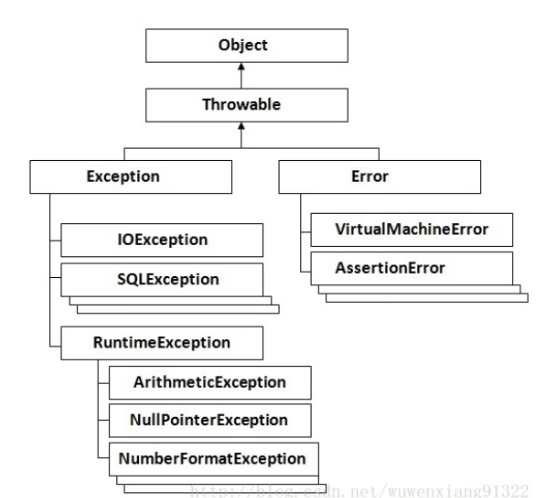@Transactional注解真的有必要声明rollbackFor属性吗?
今天在看spring的事务底层源码时,想到一个问题,@Transactional注解真的有必要声明rollbackFor属性吗?因为之前有许多资料,包括公司的java编码规范上也有提及到这一点。
不知道读者们有没想过这个问题,但我看完源码后,个人觉得是没必要的。见解不到位的话,希望读者能指明。
异常:如下图所示,我们都知道Exception分为运行时异常RuntimeException和非运行时异常(检查时异常)。

那么spring默认会对如上的哪些异常进行回滚呢?
答案:RuntimeException、Error.
spring源码如下说明:
spring在执行方法抛出异常后,会调用completeTransactionAfterThrowing方法,也在该方法中会去判断并执行是回滚还是提交操作。
protected void completeTransactionAfterThrowing(@Nullable TransactionInfo txInfo, Throwable ex) {
if (txInfo != null && txInfo.getTransactionStatus() != null) {
if (logger.isTraceEnabled()) {
logger.trace("Completing transaction for [" + txInfo.getJoinpointIdentification() +
"] after exception: " + ex);
}
// transactionAttribute的实现类为RuleBasedTransactionAttribute,父类为DefaultTransactionAttribute
if (txInfo.transactionAttribute != null && txInfo.transactionAttribute.rollbackOn(ex)) {
try {
txInfo.getTransactionManager().rollback(txInfo.getTransactionStatus());
}
catch (TransactionSystemException ex2) {
logger.error("Application exception overridden by rollback exception", ex);
ex2.initApplicationException(ex);
throw ex2;
}
catch (RuntimeException | Error ex2) {
logger.error("Application exception overridden by rollback exception", ex);
throw ex2;
}
}
else {
// We don't roll back on this exception.
// Will still roll back if TransactionStatus.isRollbackOnly() is true.
try {
txInfo.getTransactionManager().commit(txInfo.getTransactionStatus());
}
catch (TransactionSystemException ex2) {
logger.error("Application exception overridden by commit exception", ex);
ex2.initApplicationException(ex);
throw ex2;
}
catch (RuntimeException | Error ex2) {
logger.error("Application exception overridden by commit exception", ex);
throw ex2;
}
}
}
我们看到这个if分支进行分析,如果该if满足,则会进行回滚。
if (txInfo.transactionAttribute != null && txInfo.transactionAttribute.rollbackOn(ex))
查看txInfo.transactionAttribute.rollbackOn(ex)方法,其中的this.rollbackRules就是我们在@Transactional注解上配置的rollbackFor属性,
public boolean rollbackOn(Throwable ex) {
RollbackRuleAttribute winner = null;
int deepest = Integer.MAX_VALUE;
if (this.rollbackRules != null) {
// 遍历所有的RollbackRuleAttribute,判断现在抛出的异常ex是否匹配RollbackRuleAttribute中指定的异常类型的子类或本身
for (RollbackRuleAttribute rule : this.rollbackRules) {
int depth = rule.getDepth(ex);
if (depth >= 0 && depth < deepest) {
deepest = depth;
winner = rule;
}
}
}
// User superclass behavior (rollback on unchecked) if no rule matches.
if (winner == null) {
return super.rollbackOn(ex);
}
// ex所匹配的RollbackRuleAttribute,可能是NoRollbackRuleAttribute,如果是匹配的NoRollbackRuleAttribute,那就表示现在这个异常ex不用回滚
return !(winner instanceof NoRollbackRuleAttribute);
}
我这里简单配了个ServiceException。如下图

根据一:在rollbackFor属性元素遍历时,会根据getDepth方法去找抛出的异常,是不是就是我们声明的rollbackFor属性中的异常,如果是,判断是不是NoRollbackRuleAttribute类型,是的话就不回滚,否则就回滚。
再看getDepth方法,会根据抛出的异常,判断异常名字是否跟我们声明的异常是否相同,相同则返回,不同则递归抛出异常的父类,直到遍历到Throwable.class顶类。
private int getDepth(Class<?> exceptionClass, int depth) {
if (exceptionClass.getName().contains(this.exceptionName)) {
// Found it!
return depth;
}
// If we've gone as far as we can go and haven't found it...
if (exceptionClass == Throwable.class) {
return -1;
}
return getDepth(exceptionClass.getSuperclass(), depth + 1);
}
根据二:如果getDepth找不到对应的异常类,就从默认实现类DefaultTransactionAttribute.rollbackOn(Throwalbe x)方法进行判断。
@Override
public boolean rollbackOn(Throwable ex) {
return (ex instanceof RuntimeException || ex instanceof Error);
}
DefaultTransactionAttribute判断抛出的异常是RuntimeException或者Error就会进行回滚。说明spring没有对非运行时异常(检查时异常)进行处理,这是因为非运行时异常在编码时,是需要我们开发人员手动去进行try catch进行处理的,也不允许抛出非运行时异常,比如IOException,不然编译器编译都不通过,更别谈运行程序了。
总结:我们规范中要求指定rollbackFor=Exception.class,但是spring中已经包含了RuntimeException的处理,Exception的另一种实现就是非运行时异常,这种我们代码中已经处理了,所以也不需要再去指定。
标签:

留言评论